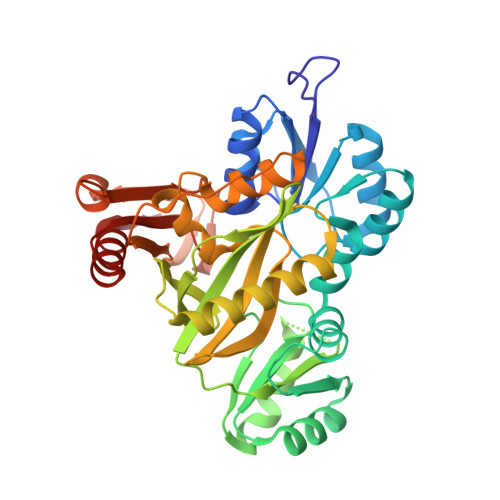PurT-encoded glycinamide ribonucleotide transformylase. Accommodation of adenosine nucleotide analogs within the active site.
Thoden, J.B., Firestine, S.M., Benkovic, S.J., Holden, H.M.(2002) J Biol Chem 277: 23898-23908
- PubMed: 11953435
- DOI: https://doi.org/10.1074/jbc.M202251200
- Primary Citation of Related Structures:
1KJ8, 1KJ9, 1KJI, 1KJJ, 1KJQ - PubMed Abstract:
PurT-encoded glycinamide ribonucleotide transformylase, or PurT transformylase, functions in purine biosynthesis by catalyzing the formylation of glycinamide ribonucleotide through a catalytic mechanism requiring Mg(2+)ATP and formate. From previous x-ray diffraction analyses, it has been demonstrated that PurT transformylase from Escherichia coli belongs to the ATP-grasp superfamily of enzymes, which are characterized by three structural motifs referred to as the A-, B-, and C-domains. In all of the ATP-grasp enzymes studied to date, the adenosine nucleotide ligands are invariably wedged between the B- and C-domains, and in some cases, such as biotin carboxylase and carbamoyl phosphate synthetase, the B-domains move significantly upon nucleotide binding. Here we present a systematic and high-resolution structural investigation of PurT transformylase complexed with various adenosine nucleotides or nucleotide analogs including Mg(2+)ATP, Mg(2+)-5'-adenylylimidodiphosphate, Mg(2+)-beta,gamma-methyleneadenosine 5'-triphosphate, Mg(2+)ATPgammaS, or Mg(2+)ADP. Taken together, these studies indicate that the conformation of the so-called "T-loop," delineated by Lys-155 to Gln-165, is highly sensitive to the chemical identity of the nucleotide situated in the binding pocket. This sensitivity to nucleotide identity is in sharp contrast to that observed for the "P-loop"-containing enzymes, in which the conformation of the binding motif is virtually unchanged in the presence or absence of nucleotides.
Organizational Affiliation:
Department of Biochemistry, University of Wisconsin, Madison, Wisconsin 53706, USA.





















